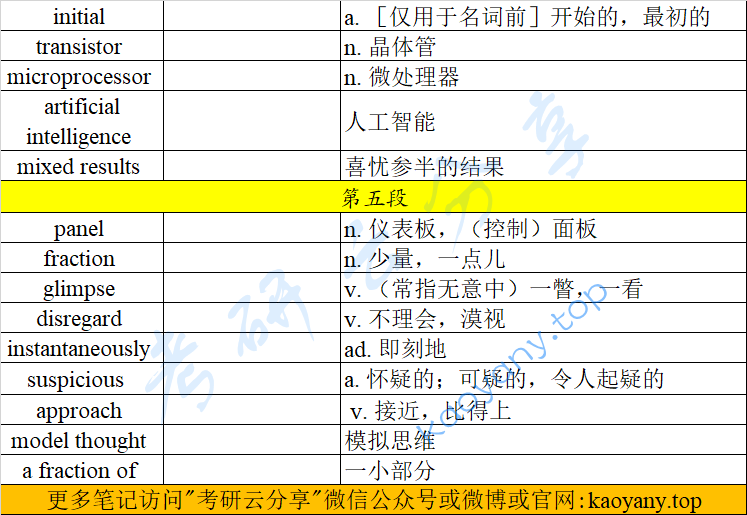第一段
①Since the dawn of human ingenuity, people have devised ever more cunning tools to cope with work that is dangerous, boring, burdensome, or just plain nasty.②That compulsion has resulted in robotics—the science of conferringvarious human capabilities on machines.③And if scientists have yet to create the mechanical version of science fiction, they have begun to come close.
单词&词组
dawn n. [用单数]开端
ingenuity n. 创造力,心灵手巧
devise v. 想出,设计
cunning a. 巧妙的
burdensome a. 难以承担的
nasty a. 极差的,令人厌恶的
compulsion n. 强制;难以抗拒的冲动
robotics n. 机器人学
confer v. 授予(称号、头衔等)
conferring... on... 将……授予……
have yet to 尚未
come close 接近
本段翻译
从初具创造力时起,人类就一直在设计日益灵巧的工具来处理那些危险、枯燥、繁重或只是令人不快的工作。这种欲望导致了机器人学将人的各种技能赋予机器的科学的诞生。尽管科学家还没有实现科幻小说的机械版,但他们已经开始接近目标了。
第二段
①As a result, the modern world is increasingly populated by intelligent gizmos whose presence we barely notice but whose universal existence has removed much human labor.②Our factories hum to the rhythm of robot assembly arms.③Our banking is done at automated teller terminalsthat thank us with mechanical politeness for the transaction.④Our subway trains are controlled by tireless robot-drivers.⑤And thanks to the continual miniaturization of electronics and micro-mechanics, there are already robot systems that can perform some kinds of brain and bone surgery with submillimeter accuracy—far greater precision than highly skilled physicians can achieve with their hands alone.
单词&词组
gizmo n. 小玩意儿,小装置
hum v. 发嗡嗡声;文中比喻“忙碌、活跃”
rhythm n. 节奏,韵律
assembly n. 聚集;安装,组装
terminal n. (计算机的)终端;终端设备
miniaturizaiton n. 小型化
submillimeter n. 亚毫米
intelligent gizmos 智能装置
remove human labor 解放人类劳动力
the rhythm of ……的旋律
automaed teller terminals 自动柜员终端
本段翻译
由此带来的结果是,智能装置日益遍布现代社会,虽然我们几乎注意不到它们的存在,但其普遍存在的确解放了大量人类劳动力。我们的工厂里轰鸣着机器人组装臂的节奏声;我们在自动柜员机终端设备上完成银行业务后,它们会用机械的礼貌用语感谢我们此次交易;我们的地铁由不知疲倦的机器人司机驾驶。且由于电子元件和微机设备不断微型化,现在有些机器人系统已经能够进行某些脑科和骨科手术,精确性达到亚毫米,远远超过技术娴熟的医生仅凭双手所能达到的精准度。
第三段
①But if robots are to reach the next stage of laborsaving utility,they will have to operate with less human supervision and be able to make at least a few decisions for themselves—goals that pose a real challenge. ②“While we know how to tell a robot to handle a specific error," says Dave Lavery, manager of a robotics program at NASA, “we can't yet give a robot enough ‘common sense’ to reliably interact with a dynamic world.”
单词&词组
laborsaving a. 节省劳力的
utility n. 实用,效用,有效性
pose a challenge 提出挑战
interact v. 互相作用,互相影响
dynamic a. 动态的,变化的
laborsaving utility 节省劳动力的应用程序
human supervision 人工监控
common sense 常识
interact with 与……互动
本段翻译
但若想机器人进一步实现节省劳力的效用,它们就必须要能在更少的人工监控下运行,且至少能够独立地做一些决定——这些目标带来一项真正的挑战。“虽然我们知道如何命令机器人去处理某个特定的错误,”美国宇航局某机器人项目的负责人戴维·拉维里说,“但是我们无法赋予它们足够的‘常识’,使其与不断变化的世界进行可靠的互动。”
第四段
①Indeed the quest for true artificial intelligence has produced very mixed results.②Despite a spell of initial optimism in the 1960s and 1970s when it appeared that transistor circuits and microprocessors might be able to copy the action of the human brain by the year 2010,researchers lately have begun to extend that forecast by decades if not centuries.
单词&词组
spell n. 一段时间
initial a. [仅用于名词前]开始的,最初的
transistor n. 晶体管
microprocessor n. 微处理器
artificial intelligence 人工智能
mixed results 喜忧参半的结果
本段翻译
实际上对真正人工智能的探索己经产生了喜忧参半的结果。尽管在20世纪60年代和70年代有过一段最初的乐观时期——那时侯晶体管电路和微处理器的发展似乎使人们相信到2010年就能实现复制人脑——但最近研究人员已开始将这个预测延后数十年,甚至数百年。
第五段
①What they found, in attempting to model thought, is that the human brain's roughly one hundred billion nerve cells are much more talented—and human perception far more complicated—than previously imagined.②They have built robots that can recognize the error of a machine panel by a fraction of a millimeter in a controlled factory environment.③But the human mind can glimpse a rapidly changing scene and immediately disregard the 98 percent that is irrelevant, instantaneously focusing on the monkey at the side of a winding forest road or the single suspicious face in a big crowd.④The most advanced computer systems on Earth can't approach that kind of ability,and neuroscientists still don’t know quite how we do it.
单词&词组
panel n. 仪表板,(控制)面板
fraction n. 少量,一点儿
glimpse v. (常指无意中)一瞥,一看
disregard v. 不理会,漠视
instantaneously ad. 即刻地
suspicious a. 怀疑的;可疑的,令人起疑的
approach v. 接近,比得上
model thought 模拟思维
a fraction of 一小部分
本段翻译
在试图模拟人类思维的过程中,研究人员发现,人类大脑的近一千亿个神经细胞远比以前想象的更聪明,人类的感知能力也复杂得多。人类已经建造了能够在受控的工厂环境里识别仪器板上若干分之一毫米差错的机器人。但是人脑只要瞥一眼快速变化的场景,就能迅速排除98%的不相干信息——立即聚焦于蜿蜒的森林小路边的一只猴子,或者一大群人中的一张可疑面孔上。世界上最先进的计算机系统也不能与这种能力相媲美,而神经科学家们至今仍然不知道我们(人类)是怎样做到的这一点。
五道题
26. Human ingenuity was initially demonstrated in_______
[A] the use of machines to produce science fiction.
[B] the wide use of machines in manufacturing industry.
[C] the invention of tools for difficult and dangerous work.
[D] the elite’s cunning tackling of dangerous and boring work.
27. The word “gizmos” (line 1, paragraph 2) most probably means_______
[A] programs [B] experts [C]devices [D]creatures
28. According to the text, what is beyond man's ability now is to design a robot that can_______
[A] fulfill delicate tasks like performing brain surgery.
[B] interact with human beings verbally.
[C] have a little common sense.
[D] respond independently to a changing world.
29. Besides reducing human labor, robots can also_______
[A] make a few decisions for themselves.
[B] deal with some errors with human intervention.
[C] improve factory environments.
[D] cultivate human creativity.
30. The author uses the example of a monkey to argue that robots are_______
[A] expected to copy human brain in internal structure.
[B] able to perceive abnormalities immediately.
[C] far less able than human brain in focusing on relevant information.
[D] best used in a controlled environment.
选项单词
delicate a. 精巧的,精心处理的
abnormality n. 异常,变态
参考答案
CCDBC
答案解析
26、[定位]第一段①句指出,自从人类萌发了创造力,就一直在发明越来越巧妙的工具来处理那些危险、枯燥、繁重或者仅仅是令人厌恶的工作。因此[C]为正确选项。
27、[定位] 第二段①句指出, 现代社会充斥着越来越多的智能gizmos, 虽然我们儿乎都注意不到它们, 但它们的普遍存在却减少了大量人类劳力。由此可知gizmos的特点是:普遍存在和节省劳力。下文提到的“工厂的机器人”、“银行的自动柜员机”、“驾驶地铁的机器人司机”、“医院做手术的机器人系统”都是对gizmos的举例说明。由此可推出gizmos指的是“机器、设备或装置”, [C] 正确。
28、[定位]第三段首句指出,下一阶段的机器人必须能够在更少的人类监控下运行,开且全少能够独立地做些决定,但这一目标向我们提出了挑战。②句指出此项挑战很艰巨的原因:机器人可以处理具体的错误,但没有足够的“常识”与不断变化的世界进行可靠的互动。由此可知,机器人目前还必须在人类监控下工作,还不能独立适应不断变化的外部环境,[D]为正确选项。
29、[定位]由上一题对第三段的分析可知,当前阶段的机器人只能在较多的人类监控下运行,可以处理具体的错误但不能独立地做决定,因此[B]的内容是机器人可以做的。
30、[定位]第五段首、末句都指出,人脑的聪明、复杂程度超出了人类自己的想象,是任何机器人所无法达到的。②③句对机器人和人脑进行比较:机器人能够快速识别仪器板上的微小差错;但是人脑瞥一眼快速变化的场景就能够迅速排除不相干信息,把注意力集中到婉蜒的森林小路边的一只猴子。显然,人脑聚焦目标的速度和精确度远远超出了机器人。[C]选项符合题意。


- 单词 词组
- 本段翻译
- 单词 词组
- 本段翻译
- 单词 词组
- 本段翻译
- 单词 词组
- 本段翻译
- 单词 词组
- 本段翻译
- 选项单词
- 参考答案
- 答案解析
